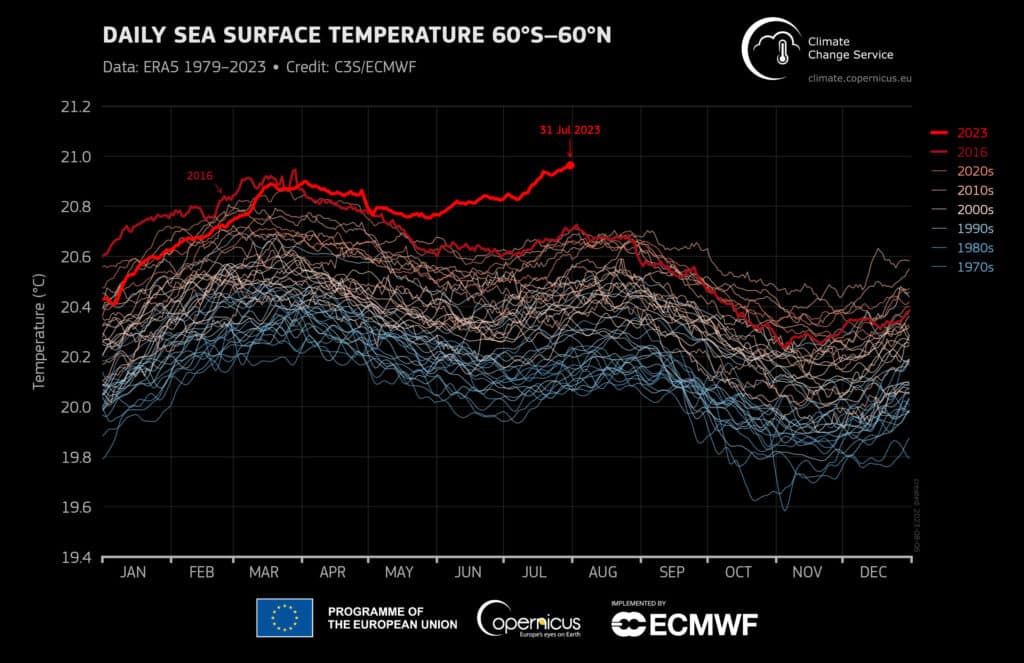
Globally averaged surface air temperature for all months of July from 1940 to 2023. Shades of blue indicate cooler-than-average years, while shades of red show years that were warmer than average. Data: ERA5. Credit: C3S/ECMWF.
Following the hottest June on record and a series of extreme weather events, including heatwaves in Europe, North America and Asia, and wildfires in Canada and Greece, ERA5 data from the Copernicus Climate Change Service (C3S) show that July 2023 was the hottest month on record globally and broke several records within the month.
The month started with the daily global mean surface air temperature record being broken on four days in a row, from 3-6 July. All days throughout the rest of July were hotter than the previous record of 16.80°C, set on 13 August 2016, making the 29 days from 3-31 July the hottest 29 days on record. The hottest day was 6 July, when the global average temperature reached 17.08°C, and the values recorded on 5 and 7 July were within 0.01°C of this. During the first and third weeks of the month, temperatures also temporarily exceeded the 1.5°C threshold above preindustrial level – a limit set in the Paris Agreement, the first time this has happened during July.
C3S data now confirm that July 2023 has been the hottest July and hottest month in the ERA5 data record, which goes back to 1940. The monthly average temperature was 16.95°C, well above the previous record of July 2019 (16.63°C) and virtually identical to our best estimate of the 1.5°C warming above preindustrial level for July (16.96°C).
Contributing to the exceptionally warm July for the globe as a whole is a long period of unusually high sea surface temperatures (SSTs). Since April, the global average daily SST has remained at record values for the time of year. From mid-May onwards, global SSTs values have reached unprecedented levels for the time of year. According to ERA5 data, on 31 July, the daily SST value reached a record high of 20.96°C, 0.01°C above the previous highest value ever recorded, of 20.95°C on 29 March 2016.

Daily global sea surface temperature (°C) averaged over the 60°S–60°N domain plotted as a time series for each year from 1 January 1979 to 31 July 2023. The years 2023 and 2016 are shown with thick lines shaded in bright red and dark red, respectively. Other years are shown with thin lines and shaded according to the decade, from blue (1970s) to brick red (2020s). Data: ERA5. Credit: C3S/ECMWF.
Carlo Buontempo, Director of C3S, comments: “Record-breaking temperatures are part of the trend of drastic increases in global temperatures. Anthropogenic emissions are ultimately the main driver of these rising temperatures. July’s record is unlikely to remain isolated this year, C3S’ seasonal forecasts indicate that over land areas temperatures are likely to be well above average.”
“The extreme weather which has affected many millions of people in July is unfortunately the harsh reality of climate change and a foretaste of the future,” said World Meteorological Organization’s Secretary-General Prof. Petteri Taalas. “The need to reduce greenhouse gas emissions is more urgent than ever before. Climate action is not a luxury but a must.”
(Adapted from material provided by Copernicus Climate Change Service)


